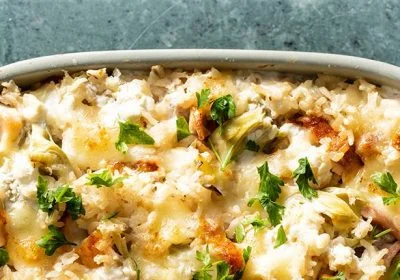The Pacific Ocean stretches the entire length of El Salvador and not only provides gorgeous views and world-class surfing, but also an abundance of seafood. Further inland, a multitude of volcanoes, some still active, provide the fertile soil for the country’s plentiful crops: maize (corn), amaranth, sesame, red beans, chilies, gourds, cassava (yuca), and tropical fruit (tamarind, chocolate, pineapple), not to mention coffee, the country’s largest agricultural export. Today’s food culture, rooted in the country’s local, natural ingredients, is a celebration of traditional recipes passed down through generations. Here are five classic recipes.
Salvadoran-Style Cheese Corn Cakes and Cabbage Slaw

Corn is one of the country’s most important foods. Ground into corn flour, it is used to thicken stews, to make a creamy, warm corn drink (atole), and to create dough for tamales. But by far the most popular way to use corn in El Salvador is the stuffed corn cake called the pupusa. It is often filled with mashed beans, loroco (a local flower bud), crispy pork skins (chicharrones), or simply with cheese. Pupusas get their deliciously toasty crust and gooey inside on the flat, cast iron cooking pan called a comal, which you’ll find in every Salvadoran kitchen.

The perfect foil for pupusas is a light and tangy slaw known as curtido. Made from shredded cabbage, carrots, and onions and dressed with vinegar and salt, curtido is homemade in large batches and is also used to top fried yuca and fried turnovers called pasteles.
Salvadoran-Style Steak and Onions

Beans, too, are an important part of the Salvadoran diet. The native red silk bean (frijol de seda) is pureed and cooked down into thick refried beans or served stewed alongside white rice. For lunch, the rice and beans are served with a fresh salad and fish or meat. Unlike the local produce that is plentiful and inexpensive, beef is mostly reserved for celebrations and large family get-togethers. The tougher cuts are made tender by stewing them slowly with root vegetables, or by pounding and marinating, as in our Steak and Onions (Bistec Encebollado) recipe. This classic dish is made by bathing cube steaks and sliced onions in mustard and Worcestershire sauce, then cooking them in a hot skillet until the steaks are well-seared and the onions are crisp-tender.
Pineapple Agua Fresca

With so much refreshing, local fruit in El Salvador, it’s no wonder it’s an important part of daily meals. Home cooks like to mix a variety of fresh fruit, like papaya, pineapple, melon, mango, and orange, into a chopped salad. When the fruit is more finely chopped and mixed with water and sugar, it is transformed into a drinkable fruit salad called refresco de ensalada. Another popular drink, fresco, calls for pureeing fruit with water and sugar. Our fresh pineapple drink (Fresco de Piña) is a classic recipe made by pureeing fresh pineapple with water and sugar, then straining out the pulp and serving it over ice.
Salvadoran Cheese Pound Cake

Coffee is an important drink in the country. Salvadorans enjoy a cup every morning for breakfast, often with a slice of the classic Salvadoran cheese pound cake called Quesadilla Salvadoreña. The cake gets its name from salty cheese that is mixed into the batter, along with sour cream, milk, and flour. The batter is sprinkled with sesame seeds and baked until golden brown. This salty-sweet, cakey combination makes for a delicious treat.
With an abundance of natural resources, Salvadoran cooking is a Central American treasure. Our recipes, adapted with ingredients found in the U.S., are a snapshot of this food culture that has delighted and nurtured generations.









